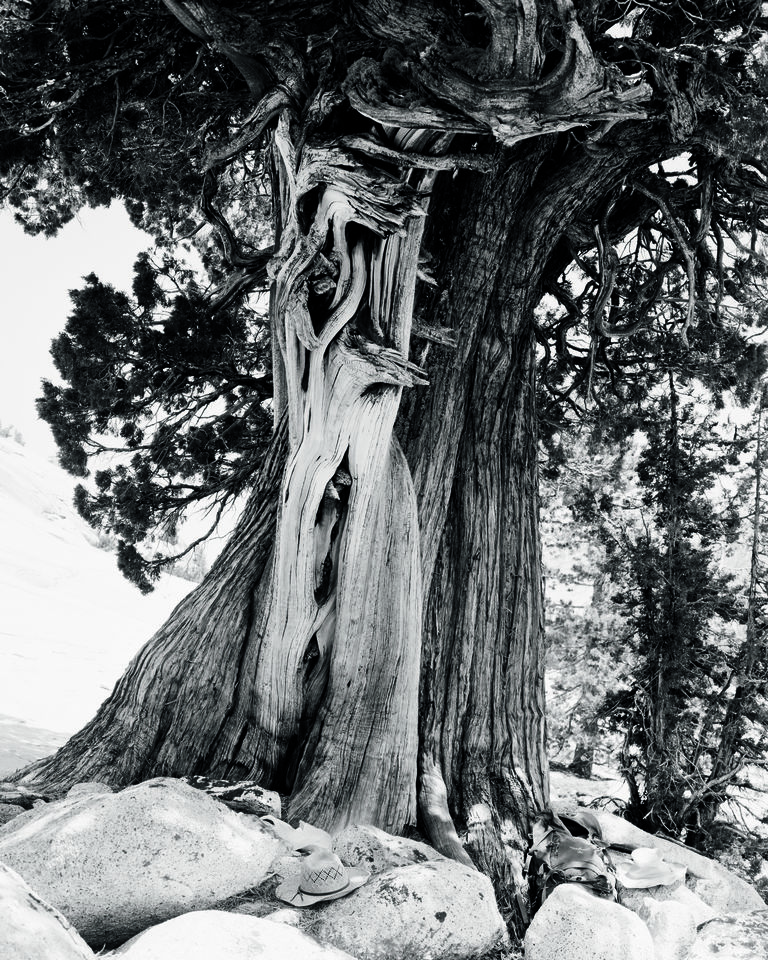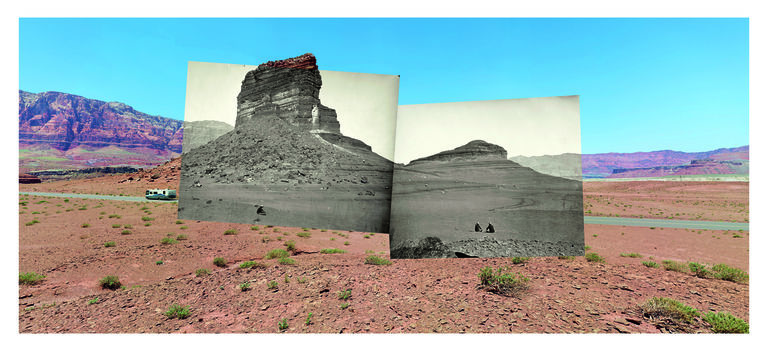Exhibition | Traces on the Landscape
On view this summer at Art on Hulfish, Traces on the Landscape brings together eight contemporary artists who employ still and moving images, poetry, sound, natural materials, and historical photographic technologies to interrogate our understanding of humans’ relationship to the natural world. Featuring works by Kelli Connell, Leah Dyjak, Emmet Gowin, Deborah Jack, Mark Klett, Dionne Lee, Byron Wolfe, and Xing Danwen, the exhibition considers the connotations of a “trace”—the sign of a former presence, a path of discovery, a piece of evidence—as a means through which photography can reveal the intersection of the natural landscape with the body, identity, and memory.
Deborah Jack (born 1970, Rotterdam, The Netherlands; active St. Maarten and Jersey City, NJ), . . .the song the tempest sings, traveled the undercurrents to be heard and . . ., 2021. Archival print on Fine Art paper, paper, gold leaf, and salt, 88.9 × 58.4 cm (frame). Courtesy of the artist. © Deborah Jack
For Deborah Jack, water, salt, and gold are enduring traces of the consequences of the transatlantic slave trade in the Caribbean, including on her home island of St. Maarten. She incorporates gold leaf and salt into her multimedia collages, bringing into the gallery the elements that circulated on trade ships that traversed the Caribbean Sea and transported enslaved Africans to labor in mines and on plantations.
Video footage of stormy seas, satellite images of swirling hurricanes, and the sound of the Rossby whistle (a pulsing hum produced by the resonance waves of a current that travels across the Caribbean basin) manifest natural cycles that were present in the era of the Middle Passage and endure today. “Hurricanes travel along similar routes and use the same winds and ocean currents that slave ships used to travel,” the artist explains. “For me, the hurricane was nature’s way of dealing with loss, with trauma, with all these bodies being carted across the ocean and perishing at sea. The hurricane was this seasonal memorial.”1 Referencing these elemental materials and natural phenomena is both metaphoric and memorializing for Jack, part of her practice of “re-memory”—a narrative framework posited by the author Toni Morrison through which the stories of African ancestors lost to history can be recuperated and transformed into collective experiences shared by their descendants.
Several artists represented in the installation mine archives, including iconic landscape photography projects and documentation from government land surveys, while others incorporate imagery from postcards and magazines of an earlier era. Kelli Connell retraces the journey of the photographer Edward Weston and his wife and model Charis Wilson across the western United States, which culminated with the photobook California and the West (1940). Connell’s project foregrounds the contributions of Wilson, who, in addition to writing the descriptive texts for the photobook, acted as navigator, driver, interlocutor, and documentarian. With her wife, Betsy Odom, Connell locates sites from California and the West and photographs Odom (or traces of her presence) at these locations. Following in the footsteps of Weston and Wilson, Connell engages questions of artistic collaboration, intimacy, and visibility in artistic partnerships.
Kelli Connell (born 1974, Oklahoma City, OK; active Chicago, IL), April, from the series Pictures for Charis, 2016, printed 2023. Inkjet print, 76.2 × 101.6 cm (frame). Courtesy of the artist. © Kelli Connell
Kelli Connell, Junipers, from the series Pictures for Charis, 2016, printed 2023. Inkjet print, 127 × 101.6 cm (frame). Courtesy of the artist. © Kelli Connell
Mark Klett and Byron Wolfe revisit images documenting nineteenth-century expeditions to the western United States—such as the photographs taken by William Bell on an army-sponsored survey of the Colorado River and the Grand Canyon—visiting these sites anew as part of their “rephotography” project, titled Reconstructing the View. While Bell traveled for months with a party of scientists, cartographers, and a crew carrying supplies, including the heavy glass negatives for his camera, Klett and Wolfe relied on digital cameras and laptops. They photographed the sites from different locations and angles, then overlaid the historical images on top of their own, using a laptop and editing program on-site to create a perfect match of perspectives.
Other photographers in the exhibition consider the nearly inconceivable scope of humankind’s ecological impact. In 1996, Emmet Gowin gained unprecedented access to the Nevada Test Site, where the United States conducted nearly one thousand nuclear tests between 1951 and 1991. He received permission to photograph the area by plane during a series of (heavily supervised) flyovers.
Gowin’s aerial photographs depict an arid desert landscape both familiar and alien. The region is pockmarked with subsidence craters, each the result of a subterranean nuclear test that had enough explosive force to vaporize huge volumes of rock and soil, causing the earth above to collapse into a giant pit. Each crater is now a geographic landmark referred to by the code name for the nuclear test that produced it. Gowin provides the history of these sites accompanied by the destructive force of each test measured in kilotons. His documentary photographs raise questions about the invisible effects of these tests, including the scope of nuclear contamination, which remains shrouded in government secrecy.
Emmet Gowin (born 1941, Danville, VA; active Princeton, NJ), Sedan Crater, Northern End of Yucca Flat Looking South, Area 10, Nevada Test Site, 1996. Gelatin silver print, 61 × 53.3 cm (frame). Collection of the artist. © Emmet Gowin / Courtesy Pace Gallery, New York
Together, the artists whose work is shown in Traces on the Landscape reenvision and reframe historical photographic practices, following the footsteps of their predecessors, bringing new valences to our understanding of iconic photographs of the natural world, and developing new visual modes for depicting how humans irrevocably change the environment we share. In doing so, they seek to redefine our relationship to the landscapes we inhabit.
Beth Gollnick
Curatorial Associate
1 Monica Uszerowicz, “Deborah Jack’s Poetic Work Draws Parallels Between Hurricanes and Caribbean History,” Artsy, November 16, 2021.
Art on Hulfish is made possible by the leadership support of Annette Merle-Smith and Princeton University. Generous support is also provided by William S. Fisher, Class of 1979, and Sakurako Fisher; J. Bryan King, Class of 1993; the New Jersey State Council on the Arts, a partner agency of the National Endowment for the Arts; John Diekman, Class of 1965, and Susan Diekman; Barbara and Gerald Essig; Rachelle Belfer Malkin, Class of 1986, and Anthony E. Malkin; the Curtis W. McGraw Foundation; Tom Tuttle, Class of 1988, and Mila Tuttle; Nancy A. Nasher, Class of 1976, and David J. Haemisegger, Class of 1976; Gene Locks, Class of 1959, and Sueyun Locks; and Palmer Square Management.




